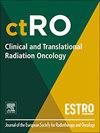使用新开发的床垫增加姑息性放疗患者舒适度:一项非随机临床试验
IF 2.7
3区 医学
Q3 ONCOLOGY
引用次数: 0
摘要
在姑息性放疗中,许多患者在治疗期间感到不适和疼痛,特别是躺在平坦、坚硬的治疗沙发上时,这被认为是准确提供治疗所必需的。薄泡沫垫,通常用于姑息治疗,可以在一定程度上减轻不适,但往往是不够的。目的:在不影响放疗质量的前提下,开发和研究一种床垫,以减轻放疗期间的疼痛。方法采用非随机临床试验将新设计的RTComfort床垫与标准的薄泡沫哑光床垫进行比较。主要终点是床垫偏好,次要终点包括疼痛经历、体位稳定性和剂量效应。纳入的患者在计划- ct采集前分别在垫子和床垫的治疗位置上测试一分钟,用数值评定量表(NRS, 0-10)对他们的偏好和疼痛进行评分。随后,对患者进行扫描并按其首选方案进行治疗。使用光学表面扫描评估治疗期间的定位稳定性,并通过使用治疗计划系统计算剂量来评估剂量学效应。结果45例患者中,44例(98%)偏爱RTComfort床垫,其中35例表现出强烈的偏好(p <;0.0001)。RTComfort床垫的中位疼痛评分从4.8 (IQR: 2.0 - 6.1)降至2.0 (IQR: 0.4 - 4.0) (p <;0.0001)。两种选择都显示患者的松弛可以忽略不计,RTComfort床垫的松弛程度略低(p <;0.0001)。未观察到相关的剂量学效应。结论:该前瞻性临床试验强调了更舒适的放射治疗的必要性。与标准的薄泡沫床垫相比,98%的患者更喜欢RTComfort床垫。RTComfort床垫在临床上显著减少了与躺在平坦坚硬的治疗沙发上相关的疼痛。该床垫对临床使用是安全的,并显示出超出姑息性放疗设置的潜力。本文章由计算机程序翻译,如有差异,请以英文原文为准。
Increasing patient comfort in palliative radiotherapy with a newly developed mattress: a nonrandomized clinical trial
Background
In palliative radiotherapy, many patients experience discomfort and pain during treatment, particularly while lying on flat, hard treatment couches that are considered essential for accurate treatment delivery. Thin foam matts, often used for palliative treatments, can somewhat reduce discomfort, but they are frequently insufficient.
Aim
In this study a mattress was developed and investigated, with the aim to reduce pain during radiotherapy treatments without affecting treatment quality.
Methods
A nonrandomized clinical trial compared the newly designed RTComfort mattress with a standard thin foam matt. The primary endpoint was mattress preference, while secondary endpoints included experienced pain, positioning stability, and dosimetric effects. Included patients tested both the mat and mattress for one minute each in the treatment position before planning-CT acquisition, scoring their preference and pain on a Numerical Rating Scale (NRS, 0–10). Subsequently, patients were scanned and treated on their preferred option. Positioning stability during treatment was evaluated using optical surface scanning and dosimetric effects were evaluated through dose calculations with the treatment planning system.
Results
Out of 45 patients, 44 (98 %) preferred the RTComfort mattress, with 35 patients showing a strong preference (p < 0.0001). The median pain score on the RTComfort mattress decreased from 4.8 (IQR: 2.0–6.1) to 2.0 (IQR: 0.4 to 4.0 NRS) (p < 0.0001). Both options showed negligible patient sagging, with marginally less on the RTComfort mattress (p < 0.0001). No relevant dosimetric effects were observed.
Conclusions
This prospective clinical trial highlights the need for more comfortable radiotherapy treatments. Compared to the standard thin foam matt, 98% of patients preferred the RTComfort mattress. The RTComfort mattress provided clinically significant reduction in pain associated with lying on flat, hard treatment couches. The mattress is safe for clinical use and shows potential beyond palliative radiotherapy settings.
求助全文
通过发布文献求助,成功后即可免费获取论文全文。
去求助
来源期刊

Clinical and Translational Radiation Oncology
Medicine-Radiology, Nuclear Medicine and Imaging
CiteScore
5.30
自引率
3.20%
发文量
114
审稿时长
40 days
 求助内容:
求助内容: 应助结果提醒方式:
应助结果提醒方式:


